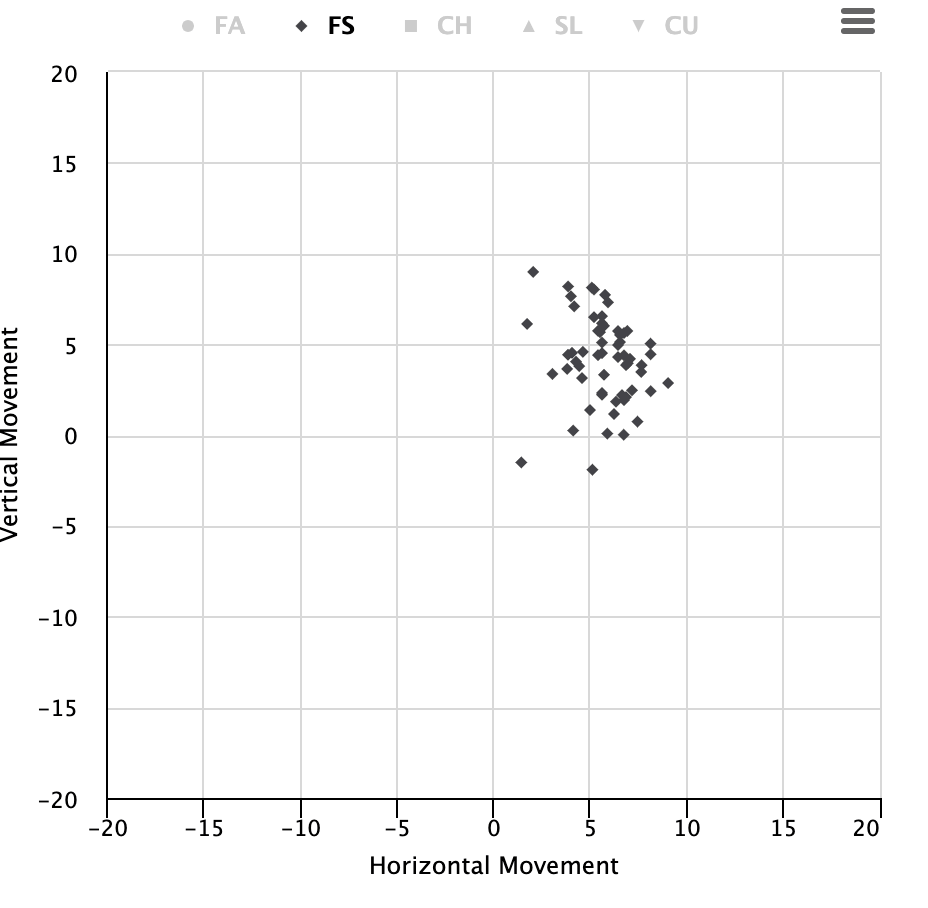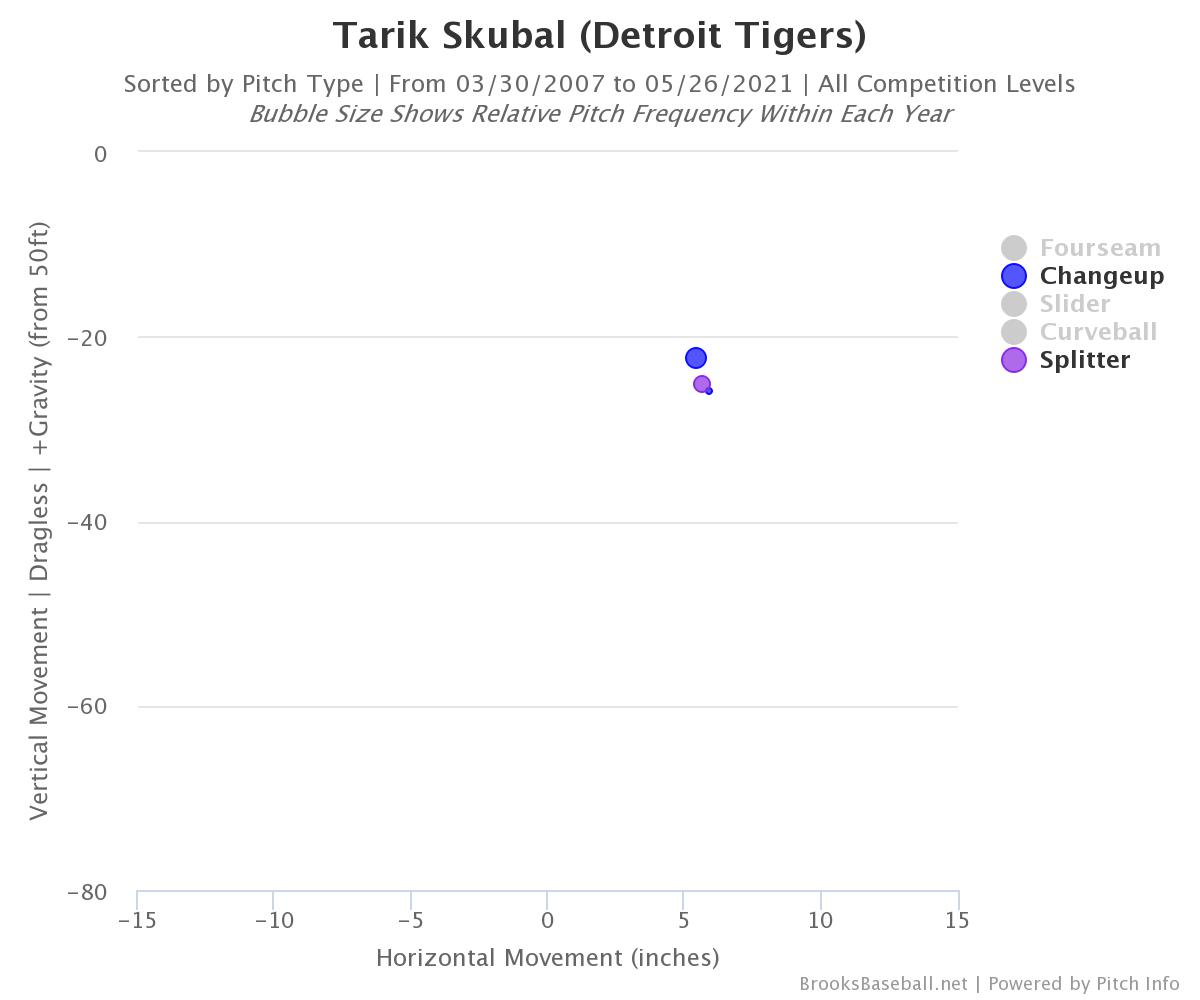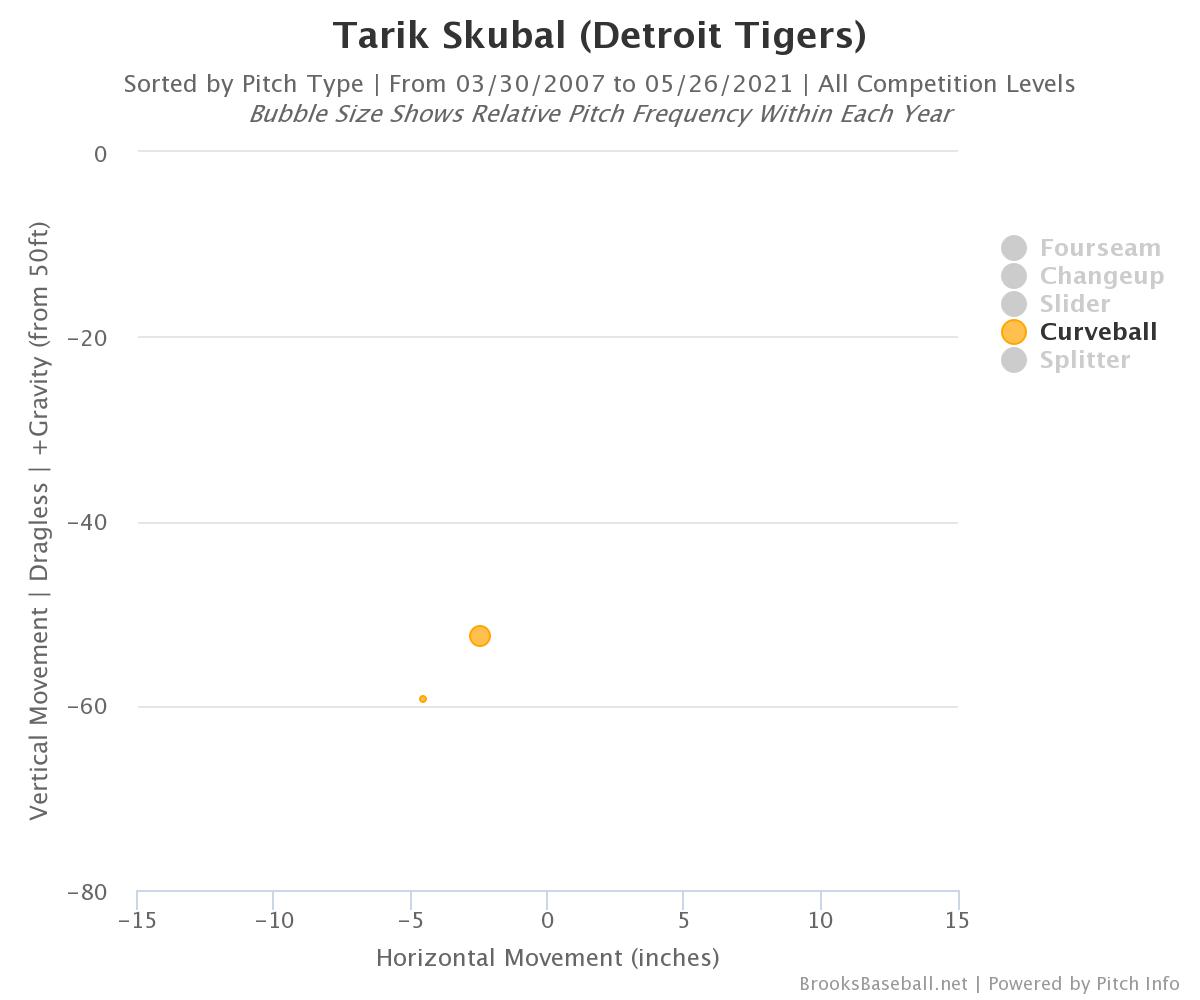When Tarik Skubal took the mound on Tuesday night against Cleveland, he was coming off his best start of the year and looking to build on whatever momentum he had built pitching against the Mariners. Two pitches into the game, things were already looking down, as Skubal missed badly with his first fastball and arguably missed worse with his second:
The catcher wanted that pitch down, if his glove is to be believed, and instead it stayed up. Cesar Hernandez isn’t known for his power, but that pitch was not going to give him any trouble.
Four pitches (three more fastballs and a change) later, Amed Rosario was on first with a walk, and then something changed. Skubal struck out José Ramírez, leaning on his slider, and then struck out Jordan Luplow mixing his fastball and slider. Skubal would go five innings, throwing 93 pitches, striking out nine, and allowing six hits. The walk to Rosario would be his only free pass of the game.
By the time the game was over, Skubal had made four starts in the month of May, all of five or more innings. In May, he has thrown 21 innings with 31 strikeouts, six walks, five home runs, and a 4.29 ERA, 4.26 FIP, and 3.14 xFIP. In his last three starts, he posted a 3.63 FIP and 3.25 xFIP. The underlying numbers are a stark improvement for the young starter.
Skubal is only 24 years old with just 75 major league innings under his belt, so it is no surprise he is a work in progress. The exciting thing is that he seems to be making tweaks that are moving him in the right direction.
A Slow Start
Skubal made his first MLB start August 18, 2020, with a bit of a rough matchup, facing a powerful White Sox team in their hitter-friendly home park. It didn’t go well: two innings, a strikeout, a walk, a home run, seven hits and four earned runs over 13 hitters. The rest of the season was a similar struggle, ending with a 5.23 ERA and 6.32 FIP. He struck out plenty (27.6%), walked about an average amount (8.2%), but gave up far too many hits and home runs (2.53 HR/9).
A couple of weeks after that rough debut, Zach Hayes offered some great insights into what was happening with Skubal. His fastball was finding too much of the plate (go back and watch the Cesar Hernandez bomb again) and his secondaries weren’t doing their job. Rather than rehash what Zach wrote, I strongly encourage you to take the time to read that article. I’ll wait. But if you don’t want to click over, the summary is that Skubal’s fastball looks exciting, but that lack of effective secondaries means he relies on it too heavily and the lack of command means it can get hit hard. (Important note: A big, BIG thanks to Zach for his help researching and writing this article).
A New Secondary
In that piece last year, Zach talked about Skubal using his fastball and slider as a 1-2 punch. By the end of the season, Skubal had thrown his fastball 58.9% of the time, his slider 15.7%, and his changeup 16.4%. He mixed in an occasional curveball (7.8%), but the curve got hit hard and he clearly didn’t trust it.
Knowing he needed his secondary pitches to step up, Skubal spent time during the off-season at Driveline developing a splitter — a new off-speed pitch to pair with his fastball and hopefully get better results. He went to that split finger pitch right out of the gate in 2021, using it in place of his change. This April, he threw the splitter 13.1% of the time (not too far off the 16.4% he used the change last year) but didn’t throw a single changeup.
Here you can see his last changeup from 2020, followed by his third splitter of 2021 (the first two were bounced):
If they look a little similar to you, it’s because in some ways they are.
The data and charts in the last gif, immediately above, come from FanGraphs. The splitter has about the same horizontal movement, but a bit more vertical movement than his old changeup. It’s also two mph faster (85.1 vs. 83.1).
More movement seems good, but the added velocity wasn’t necessarily a benefit, given that this is supposed to be Skubal’s off-speed pitch. To make matters worse, Skubal seemed to lose something off his fastball when throwing the splitter. Skubal averaged 94.4 mph on his fastball in 2020; in April 2021, that was down to 93.8. It’s hard to know if that is somehow because of the splitter, but Detroit News Tigers beat reporter Chris McCosky noted that Skubal got advice from his manager and pitching coach to “back off the splitter until he got his fastball back.”
Back to the Old Secondary
And so before his May 7 start against Minnesota, Skubal ditched the splitter and brought back his changeup, but not the exact same changeup.
That large blue dot is the 2020 changeup. The large purple dot is his splitter. And that small blue dot, looking a bit like a moon in orbit around the purple dot — is his 2021 changeup. It has a bit more movement than the splitter did. It’s also 82.0 mph on average, which is 3.1 mph slower than the split and 1.1 mph slower than his 2020 changeup.
This is a great illustration of the kind of process it takes to get pitches and pitch mix right. Skubal started with a changeup in 2020, but his secondaries weren’t doing enough for him. He developed the splitter, which gave him similar horizontal movement and more vertical movement but put more speed on his off-speed pitch. He then went to a modified version of the changeup, which kept that vertical movement. Then he ditched that for a new change, was able to keep the increased vertical movement and decrease the velocity.
Even better, with the splitter gone, Skubal got his fastball velocity back. From 93.8 mph in April with the splitter, it bumped to 94.6 mph in May with the change. In his most recent start, it was up to 95.0 mph.
That may not seem like a whole lot, but one of the most important factors to the effectiveness of an off-speed pitch is the separation from the fastball. The hard splitter and slow(er) fastball had just 8.7 mph of separation. The new, slower changeup and the revitalized fastball have averaged 12.6 mph of separation. That is a huge shift that shows how effective a pitcher’s off-speed pitch can be in keeping hitters off balance.
I don’t want to suggest that losing the splitter is the explanation for the increased fastball velocity. Velocities increase as the season goes on anyway and it is quite possible that Skubal was simply building up velocity and benefiting from improving weather. But it’s at least interesting that his manager and pitching coach suggested he drop the splitter until his fastball velocity came back and his fastball velocity came back almost immediately. Maybe it even suggests he was having a tougher time maintaining his arm speed when he was throwing both.
Improving Another Secondary
The new and improved changeup isn’t the only difference maker for Skubal. He’s also started to use his curve a bit more. In 2020, he was using it 7.8% of the time, but that was down to 5.8% in April and is back up to 8.0% in May. But more importantly, the pitch is a lot more effective. Hitters posted a .441 xwOBA off his curve in 2020 and in 2021 that is down to .201.
Here is a 2020 curve to Nomar Mazara.
Mazara doesn’t exactly crush it, but it catches too much of the zone – the catcher is set up down and away and that pitch ends up over the plate and about thigh-high.
Here is a curve in 2021 to Jason Heyward.
The catcher sets up in almost the same spot, but this time Skubal buries the pitch and Heyward waves at it.
Now, that could just be better execution of the same pitch, but — like the changeup — the numbers suggest this is an improved pitch.
That big dot is his 2020 curve; the small one is 2021. That is a pitch getting about twice as much horizontal movement and a lot more drop. In 2020, his curve averaged 76.6 mph. In 2021, it is down to 73.7. That decrease in speed is helping him get increased vertical movement — there’s more time for gravity to pull that ball down — but he is also just throwing the pitch more effectively. The active spin (a measure of how much of the spin on a pitch is contributing to movement) on his curve is up to 85% from 72% last year. The total movement is up from 15.3 inches to 20.1.
This further differentiates his curve from his slider. As Zach pointed out last year, Skubal’s slider is primarily a vertical pitch, dropping about half as much as his curve with very limited horizontal movement. With the new movement on his curveball, those two pitches force the hitter to look for two very different things and give him an arsenal that can move a lot of different directions.
What’s Next
Towards the end of his piece, Zach commented, “Unless the curveball or change takes a big step up, however, Skubal still seems likely to go only as far as the fastball-slider combination will take him.” Based on what we have seen in May, it appears Skubal’s curveball and change have both taken a big step up. How much more effective are those two pitches? Check out the improvement in CSW:
| Year | Curve | Change |
| 2020 | 21.7% | 24.7% |
| 2021 | 33.9% | 30.4% |
Improving the curve and bringing back the upgraded changeup took Skubal from an overall 27.4% CSW in 2020 and 24.4% in April, to 31.2% in his four starts in May.
His pitch mix is still evolving. As his secondaries have improved, he is using his fastball a bit less, down to 53.2% this year. He increased his slider usage a lot in April, from 15.7% last year to 26.7%, but brought it back down to 20.9% in May, in favor of more curveballs and off-speed pitches (17.4% changeups in May vs. 13.1% splitters in April). I suspect he’ll continue to tweak this. Given the increasing effectiveness of the curve and change, I wonder if we’ll see those continue to get used more at the expense of his fastball.
Skubal’s May starts have not been against the toughest competition. After an early May date with a power-happy but scuffling Twins team, he faced the Cubs, pitched at Seattle, and hosted Cleveland. Tomorrow he gets a scarier assignment, as the banged-up-but-still-terrifying Yankees are in town. Next weekend he likely gets the White Sox. Those are some big tests and some rough spots are to be expected.
Development is rarely linear and Skubal still has work ahead of him, but this is pretty exciting. Skubal is by no means a finished product, but at just 24 and with the Tigers still a year or two from competing, he doesn’t have to be. He is an extremely talented pitcher with an exciting fastball showing real strides on his secondaries.




Tremendous analysis. I loved this article, and the companion piece from last year. Keep it up.